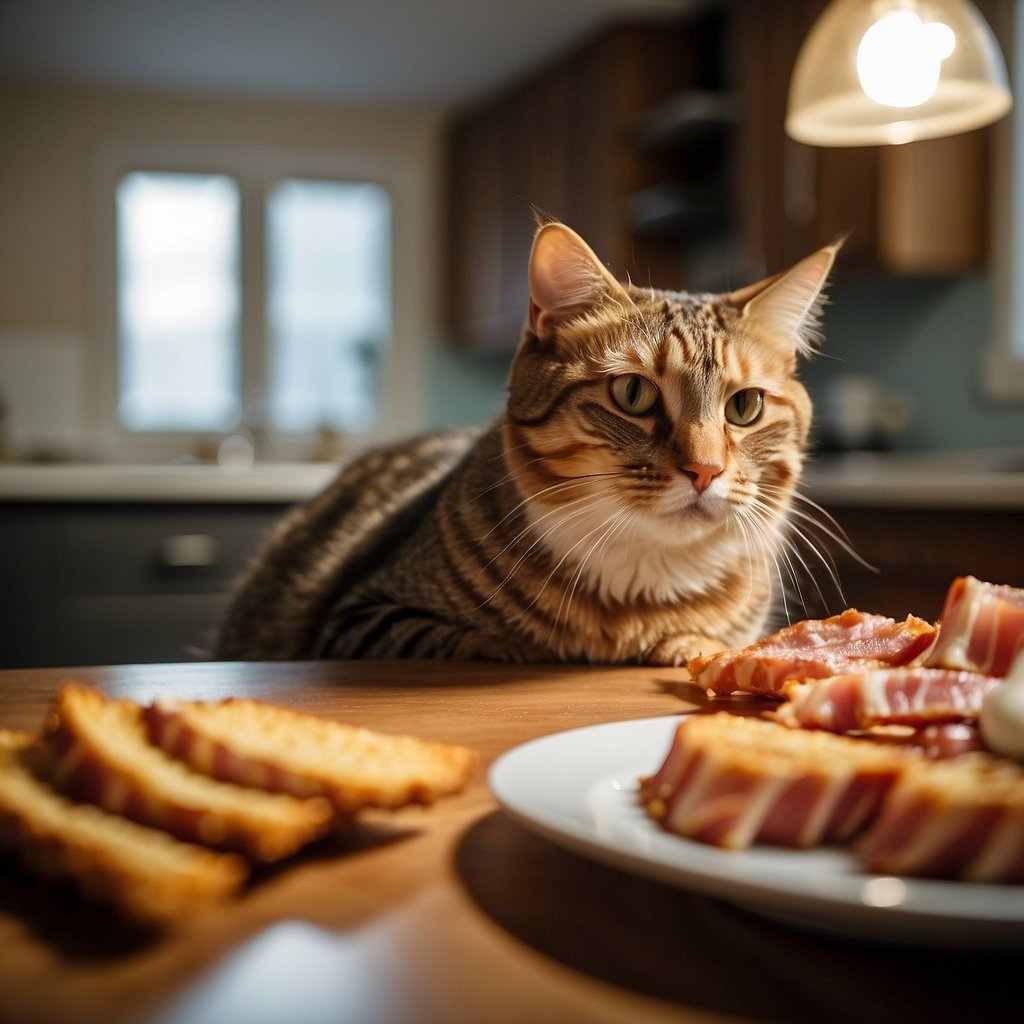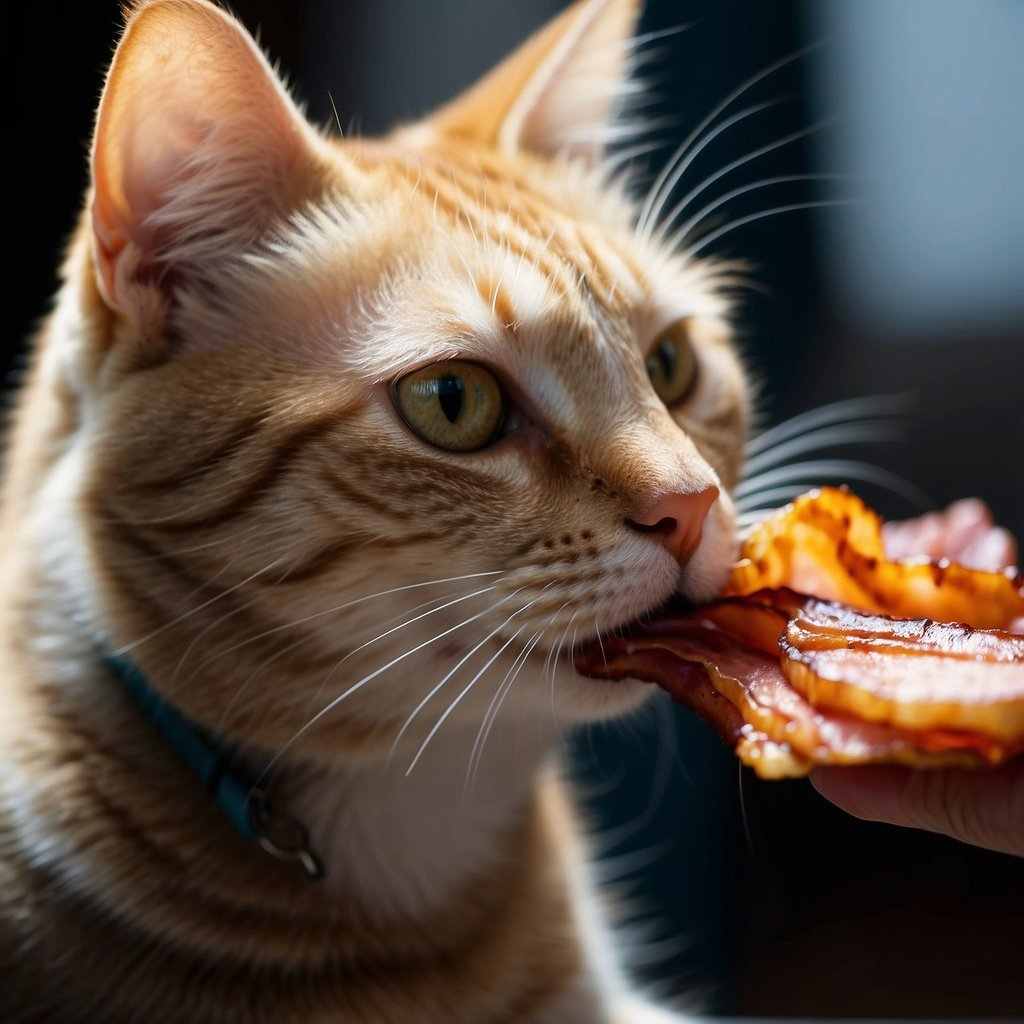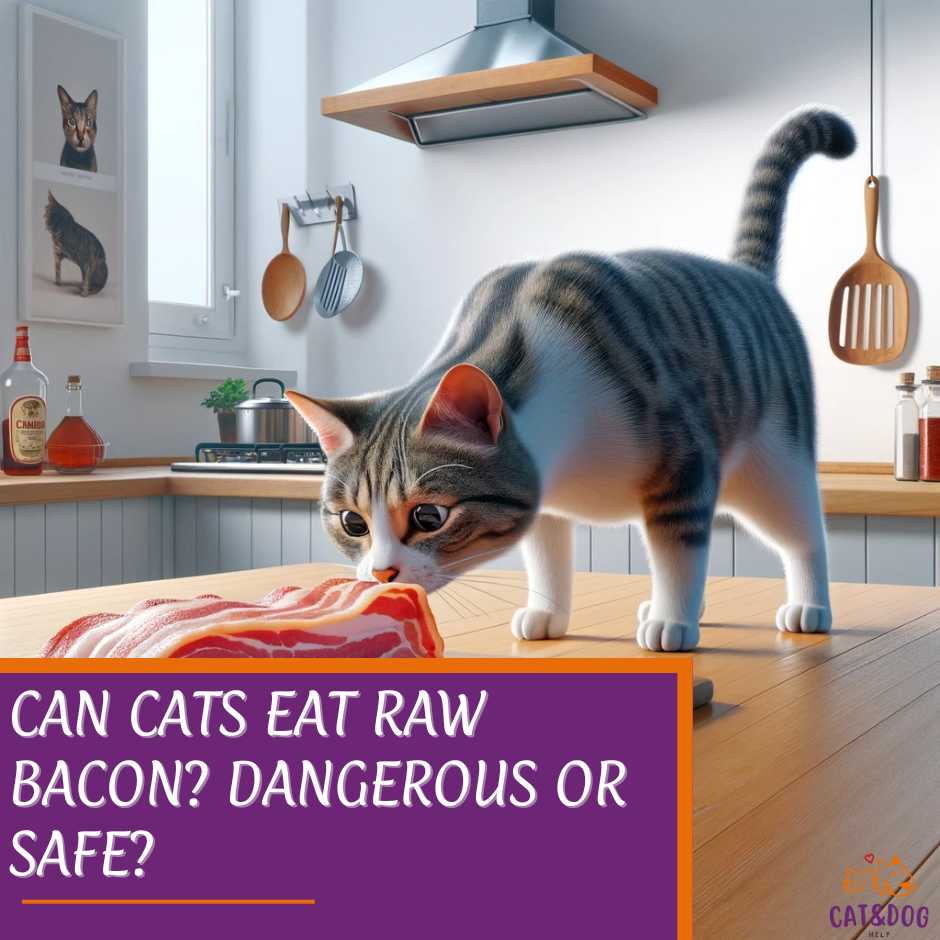Can cats eat raw bacon? When it comes to pampering our feline friends, we often wonder if it’s safe to share some of our favorite treats with them.
Take bacon, for instance—a favorite breakfast side for many of us. You may find your cat eyeing a slice of bacon with interest, but you’ve heard mixed advice about whether it’s safe to let them indulge in raw bacon.
As obligate carnivores, our feline family members need meat to thrive, but does that mean all meats, including bacon, are on the menu?
Felines are obligate carnivores, which means they’re designed to eat meat and receive the vast majority of their nutritional needs from it. (1)
This includes a vital amount of protein and an essential amino acid called taurine, which is critical to maintaining many healthy functions of your kitty, such as heart and vision. (2)
Special snacks are always great rewards for bonding and training.
However, Dr. Renee Rucinsky, owner of Mid Atlantic Cat Hospital and Feline Thyroid Center in Queenstown, MD, recommends choosing a variety of shapes and flavors of commercial treats and cat-friendly homemade goodies, such as tuna and catnip bites.
While there’s a little goodness in every slice of standard pork bacon, it’s best to offer your cat a healthier treat that provides more nutritional benefits, one that provides more nutritional bang for their buck.

Meat is indeed a staple in a cat’s diet, but not all types are suitable for your pet, and preparation is key. Raw bacon, like cat food, is a concern due to potential parasites, high sodium content, and fat levels. (3)
While you might be tempted to toss a piece of standard pork bacon to your kitty, understanding the impact of raw bacon on cats is critical.
Ensuring their diet remains balanced and safe is more than just good pet parenting—it’s crucial for their health and happiness.
However, it’s important to note that a commercially available, reputable, complete cat food based on raw meat might be a better option for their overall well-being.
Cats love bacon because of its aroma, crunchy texture (which resembles dry food), fat content, and the fact that they can enjoy it regularly. None of that honey BBQ or black pepper stuff. (4)
Key Takeaways
- Cats have specific dietary needs and not all meats, including raw bacon, are suitable for them.
- Raw bacon can pose health risks to cats due to parasites, high sodium, and fat content.
- Safe feeding practices for cat
- Food is essential for maintaining a cat’s health.
Can Cats Eat Raw Bacon?
Ever wondered if that savory strip of unsmoked ham could be a rare treat of bacon meat for your feline friend? Let’s chew over the facts, shall we?
Raw bacon is a meat product that’s high in both fat and sodium, which seems all right at first glance, considering your cat’s carnivorous menu preferences. (5)
However, when we dive into the nutritional content, we find that raw bacon might not be the perfect choice due to its high amount of sodium and grams of fat.
Nutritional Content of Raw Bacon:
- Fat: High levels that exceed a cat’s dietary needs
- Protein: While essential, it’s the quality, not quantity, that counts
- Sodium: Far exceeds the daily recommended intake for cats
A cat’s ideal diet should be high in protein and moderate in fats, with a minimal amount of sodium. Now, how does raw bacon compare?
| Nutrient | Raw Bacon | Cat’s Ideal Diet |
| Protein | Sufficient | High Quality |
| Fat | Excessive | Moderate |
| Sodium | Too High | Minimal |
Risks Associated with Feeding Raw Bacon to Cats
Sure, cats need a diet rich in meat, but raw bacon?
That’s where we hit a snag. The risks of bacteria like Salmonella and E. coli in raw bacon are no joke; you don’t want your furry friend to end up with an unwanted bellyache or worse. (6)
Consider these facts and figures:
- High Fat: Love handles aren’t just a human worry. Excessive fat can lead to obesity in cats, yikes!
- Sodium Overload: Too much salt isn’t just a flavor of faux pas. It can cause serious health issues like sodium ion poisoning.
Veterinary cases have shown the dangers of feeding cats diets high in fat and sodium, leading to complexities such as pancreatitis and heart issues. (7)
Your cat’s health isn’t something to gamble with, even if those bacon bits look like tasty dice. Let’s leave raw bacon off the cat menu, and stick to treats that will keep those nine lives long and thriving.
However, it’s not a good idea to give your cat bacon because it’s very high in fat and salt. If they sneak a small amount of bacon when you’re not looking, you don’t need to rush to the vet.
A small indulgence won’t cause harm, but it’s important to remember that moderation is key. Adding a little bit of bacon to your cat’s diet can be permissible, as long as it’s cooked and the fat is removed.
Remember, a piece the size of your fingernail might seem stingy, but it’s more than enough for your cat.
Expert Veterinary Insights on Raw Bacon for Cats
Ever found yourself nibbling on some crispy bacon and caught your feline friend eyeing you with that “Can I have some?” look?
You may be tempted to share, but let’s pounce on what the experts say about cats and raw bacon.
First things first, raw bacon is a no-go. Why, you ask? Let’s break it down:
- Parasites & Bacteria: Raw bacon can harbor unfriendly hitchhikers like parasites and harmful bacteria. This isn’t just a tale to scare you; it’s a real health risk. (8)
- High-Fat Content: Bacon is like the fat cat of the meat world—loaded with fat! Too much can lead to an upset stomach or even pancreatitis in your purring pal.
“But my cat is a carnivore, so meat should be fine, right?” True, cats need protein, but not all meats are created equal, especially when it comes to your pet’s balanced diet.
Here’s what a vet might tell you:
- Cooked bacon, as an occasional treat, is safer than raw.
- Even then, trim visible fat and keep the portions tiny. Yes, tiny like the toe beans on your kitty’s paws.
Myth Buster Alert: Raw bacon is healthier, right? Wrong. It’s a myth. Despite being carnivores, cats benefit from high-quality, cooked proteins, not the raw stuff that could make them sick.
Remember that anecdote about the tenacious tabby that ate a hunk of bacon and spent a week at the vet’s? Let’s not have your kitty with sensitive stomachs be the next cautionary tail, uh, tale.
Stick to safe, cat-friendly treats like turkey bacon and occasional bacon morsels, and keep track of the bacon’s high amounts of fat and sodium.
As always, consult your vet for the best dietary advice for your feline friend.
If your kitty is already dealing with certain gastrointestinal issues, such as pancreatitis, stick with the cat food and treats recommended for pancreatitis by your veterinarian, and don’t let your tenacious tabby pilfer any fatty bit of bacon from your plate.
Your cat shouldn’t ever eat bacon grease, so take care to rest her treat piece on a paper towel, then blot the rest of the grease off it.
Remove the fatty bit from the meat, then dice up the meat and offer it to your kitty—if she loves it, you could use it as an occasional food topper if your cat isn’t eating.
Let’s look at some other types of bacon. Avoid other meat-based foods such as sausages, and canned meat foods which can affect your cat’s health.
However, if you choose to fry or bake standard pork bacon or Canadian bacon for your cat, you’ll have to take on a few more preparation steps than usual.
Safe Feeding Practices for Cats

When it comes to treating your feline friend, who can resist those pleading eyes?
But before you cave, remember that not all treats are created equal, especially not raw bacon. Let’s chat about some healthier options and how to introduce them, shall we?
Healthy Alternatives to Raw Bacon
Your kitty deserves the best, and when it comes to treats, balance is crucial. Here are a few tail-wagging options:
- Cooked Meat: Small pieces of chicken or turkey, cooked without spices, are great protein-packed alternatives.
- Canned Pumpkin: A spoonful can aid digestion. Just make sure it’s pure and not pie filling!
- Cooked Carrots: Full of vitamins but low in calories; perfect for crunchy treat time.
- Scrambled Eggs: Cook them plain and serve in moderation for a boost of protein and amino acids.
The rule of thumb? Treats should only make up about 10% of your cat’s daily intake. Keep it lean and mean!
Guidelines for Introducing New Foods
Bringing in new treats can be an adventure for both you and your kitty. Follow these steps to keep it fun and safe:
- Start Small: A tiny bite of the new snack is enough to kick off the taste test.
- Monitor: Keep an eye on your furball for any funny business or signs of an upset stomach.
- Slow and Steady: If all’s well, gradually increase the treat size over time.
If you notice any odd behavior, such as vomiting or lethargy, it’s time to pause and possibly consult your vet. It’s better to be the overprotective parent here!
Incorporating safe and nutritious treats into your cat’s diet is like a purr-sonalized act of love.
By following these guidelines, you’re not just giving your cat a tasty snack; you’re helping maintain their health and happiness. Now, that’s what I call a win-win!
Quick Recap

Feeding your cat raw bacon might seem like a treat, but let’s get to the meat of the matter: it’s not the best idea.
Now, you love your furry friend, and you want what’s best for them, right? Raw bacon is high in fat and salt, which aren’t great for your cat’s waistline or blood pressure. And nobody wants an unhappy vet bill, correct?
Here’s what you should chew over:
- Bacterial Contamination: Just like us, cats can fall sick from bacteria like Salmonella or E. coli. Raw meats can harbor these nasties, so it’s a no-go.
- Nutritional Balance: Your cat’s commercial food covers the essential minerals they need. They require about 740 milligrams of sodium daily, and added salt from bacon is just overkill.
- Healthy Treats: Looking for a safe snack? Stick to veterinarian-approved treats.
- Moderation is Key: If you still want to share a bit of cooked bacon, keep it to a tiny amount and only on rare occasions.
Remember, your cat relies on you to make good choices for their health. Their purrs and head bumps are a good sign you’re doing things right—no raw bacon is needed to strengthen that bond.
Keep these points in mind, and you’ll be on your way to ensuring your cat stays happy, healthy, and active!
Frequently Asked Questions
Here’s a quick rundown of common human foods, whether they’re a feline-friendly treat, and how they should be given to ensure your cat’s safety and health.
What are the safest human foods I can share with my feline friend?
Your concern for your cat’s diet is admirable! Lean meats like cooked chicken, turkey, and lean beef can be great in moderation.
Always fully cook these meats and avoid any fatty portions or skin to prevent stomach upset.
Are there any benefits for my kitty in eating raw beef, and how should it be prepared?
Feeding raw beef to your cat should be approached with caution. While raw diets have their proponents, there’s a risk of bacterial contamination.
If you choose this route, ensure the beef is fresh, and handled hygienically, and consult your vet for safe preparation practices.
Given that poultry is a go-to protein, can my cat indulge in raw chicken?
Although poultry is a great source of protein, raw chicken is not recommended due to the risk of salmonella and other bacterial infections.
Stick to cooking it thoroughly without any harmful seasonings or oils to keep mealtime both enjoyable and safe for your kitty.
I’ve heard mixed opinions, but is it harmful for my cat to consume raw eggs?
Let’s crack this one open: raw eggs can contain salmonella or E. coli, which are a no-go for cats.
Not to mention, an enzyme in raw eggs interferes with the absorption of a vital B vitamin.
To avoid health issues, eggs should always be cooked before offering them to your feline pal.
Fish is commonly associated with cats, but is raw fish a healthy option for them?
Fish tales aside, raw fish isn’t the best choice for cats due to potential bacteria and the enzyme thiaminase that breaks down an essential B vitamin.
Occasionally serving cooked, boneless fish can provide omega-3 fatty acids and proteins that can benefit your cat, though.
Cooked or raw, what kinds of pork products are off-limits for cats?
Pork products, particularly processed ones like bacon or ham, are high in salt and fat, which are not suited for your cat’s diet.
In addition, raw pork can harbor parasites and pathogens. It’s best to keep these types of products away from your cat’s reach altogether.


